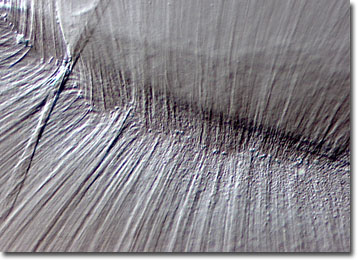Differential Interference Contrast Image Gallery
Chicken Embryo Lens
Baby chickens, or chicks, have been symbols of springtime and the renewal of life in many cultures throughout history, and aptly so. From the time a fertilized egg is laid by a mother hen, the complete development of the chick only takes 21 days to complete.

Although initially all cells within a chicken embryo look alike, they quickly begin to develop into specialized structures. Within the first 24 hours of embryonic development, the head becomes distinguishable, the foregut forms, blood begins to accumulate in areas that will become parts of the vascular system, and the eye starts to take shape. Developmental progression moves swiftly, and on the second day the lenses of the eyes materialize, the vascular system takes a definite form, and the heart begins beating. The lightning-fast pace of growth and change continues, each feature developing within a set period of time, until a few short weeks later a full-formed and functional baby chicken, complete with claws and feathers, taps it way out of its shell to first see the light of day.
Newly hatched chicks should be provided with food and water soon after they emerge so that they can quickly learn how to eat and drink, even though they obtain some sustenance from the yolk incorporated into their bodies for a short period of time. Chickens primarily eat grain and the amount and composition of the feed they are usually provided is dependent upon their stage of development. Interestingly, the feeding habits of chickens have been of significant interest to behavioral scientists. Studies have shown that chickens are, in a sense, subject to “peer pressure.” For instance, chickens that have already eaten to satiation will begin feeding again if they observe other chickens eating.
